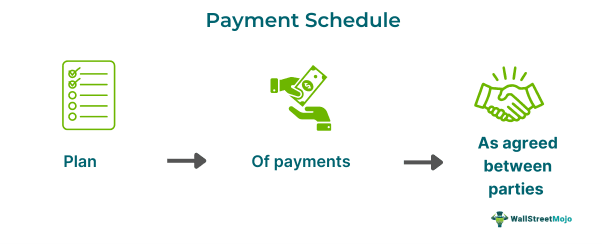Table of Contents
Payment Schedule Meaning
A payment schedule is a plan agreed upon between parties, defining the timings, frequency, and number of payments involved. It includes details such as the mode of payment and the type of payment that needs to be made. Additionally, it mentions interest rates, fees, and other relevant information.

It helps both parties clearly understand the payment deadlines and the related terms and conditions. The method ensures transparency and accountability from both ends. Moreover, it helps avoid late payments, facilitates smooth transactions, and reduces disputes. It is common in loan arrangements, mortgages, and similar contractual obligations.
Key Takeaways
- A payment schedule is a process of scheduling payments that are agreed between parties. It defines the timings, frequency, and the amount of payments involved.
- It includes details such as the mode of payment and the type of payment that needs to be made. It mentions the due dates, interest rates, fees, etc.
- It helps the borrower maintain financial discipline and maintain commitment toward their goals.
- It is an organized method of receiving payments and helps the lender maintain their cash flow. Such schedules promote accountability and transparency in the process as they serve as a record of proof and help in dispute resolution.
Payment Schedule Explained
Payment schedules are plans that outline the payment timings, duration, and amount to be paid. They automatically pay on a future date, depending on the arrangements between creditors and borrowers. Hence, the plan also includes details such as the last date, interest to be paid on being late, additional fees concerning the transactions, etc. It clearly defines the expectations and obligations to be fulfilled by the involved party.
It typically has information such as the total amount of liability and the frequency of payments such as annual, quarterly, half-yearly, or even monthly. The due dates of each payment and the specific amount paid (proportional or equal installments) are also mentioned.
It is often used in financial arrangements where continuous payments are required. The payment schedule in Excel can include payments for leases, mortgages, and contractual arrangements such as buying a house. It provides a structured method of closing an obligation. This ensures timely payment in accurate amounts.
These schedules include penalties and late fees in case of default, ensuring that the parties understand the full cost involved. Furthermore, they ensure continuous cash flow for the creditor and help budget for the debtor. They also help borrowers be financially disciplined to meet their obligations. Through this arrangement, both parties can be organized and able to track the progress of the payments.
The Hargreaves Lansdown provides access to a range of investment products and services for UK investors.
Types
The various types of such schedules are listed below:
- Lump sum schedule of payments: Lump sum arrangements outline the payment schedule as a one-time full payment. They are most suitable for big purchases such as annual rent payments or buying a house or car.
- Schedule of payments in installments: Installments are payments to be made in equal amounts over a given period. They are common in buying properties, where the payments are made in monthly schedules. They can also be used in amortization payment schedules.
- Deferred schedule of payments: Under this type of arrangement, the payments come with the flexibility of being paid at a later date, often accompanied by an interest. Examples include credit card balances. Sometimes, the more delay there is, the higher the interest.
- Fixed schedule of payments: A fixed schedule of payments comes with a fixed, consistent payment deadline. This provides more clarity in terms of payments to be made and, hence, predictability.
- Variable schedule of payments: Such payments have dates that offer flexibility based on certain criteria. Sales and revenue sharing in partnership agreements are one such example.
- Milestone schedule of payments: Payments under this category are made after reaching a certain point in the agreement. For example, the construction of a house has different stages of completion, and payments are made at each stage.
- Revolving, parameterizing and customizing schedule of payments: Revolving payments allow flexible payments as long as the specific minimum payment requirement is met. Parameterized payments are flexible plans that allow customization of amounts and timing based on predefined conditions. Customized payments offer flexibility on a wider scale where timing, amount, and duration can all be customized to an individual's payment preferences.
Examples
Let us look into examples that can give a better understanding of the topic.
Example #1
Imagine Dan is a salaried employee who wants to buy a house. The one-time payment is a huge financial debt for Dan. He uses a loan payment schedule calculator and decides to take a loan. Once he has bought the house, all he has to do is make monthly payments to the bank. The bank, based on the loan amount and the interest rate, decides the monthly rate and period. Now, Dan can own a house and systematically manage his liabilities.
Example #2
The US government provides certain benefits to people who need aid. Hence, the government has a scheduled payment date for selected members. The schedule for each year is given on the website. The payment schedule for social security typically occurs on the third day of each month, as well as on the second, third, and fourth Wednesday of each month.
Importance
Below are some points that highlight its importance:
- It helps the borrower budget their expenses to manage their repayments better.
- It helps the borrower split large payments into manageable small payments as installments.
- This arrangement helps the borrower and the lender achieve their financial goals through proper planning.
- It helps the lender keep track of their cash flow by clearly indicating the date the money comes in.
- It helps both parties to plan their future according to the clearance of the obligation.
- It offers flexibility to the borrower and the lender through customization.
- A clear plan helps avoid missed deadlines and the associated late fees or charges.
- It serves as a clear record of payment history. This helps the parties in dispute resolution.
Disclosure: This article contains affiliate links. If you sign up through these links, we may earn a small commission at no extra cost to you.

